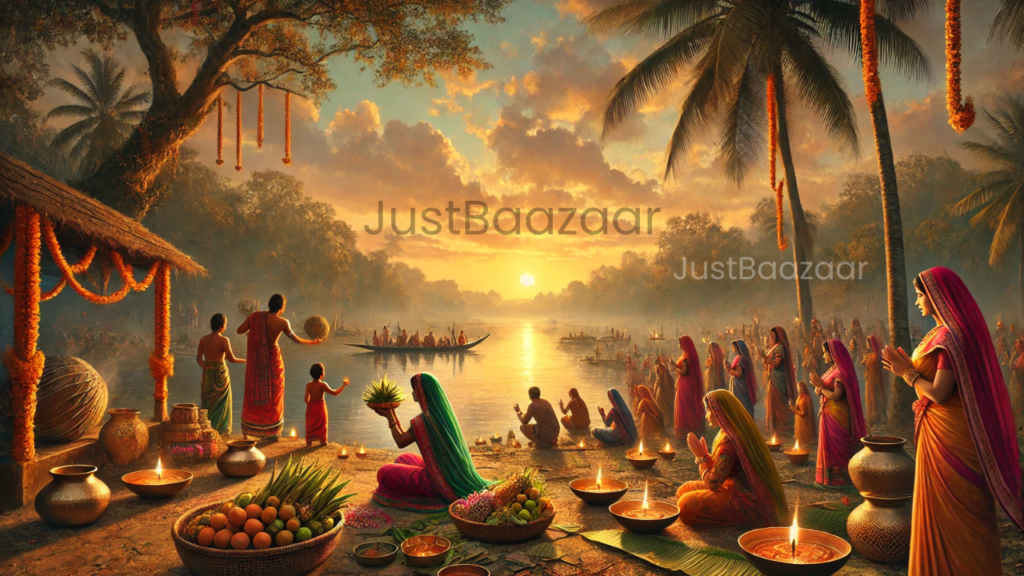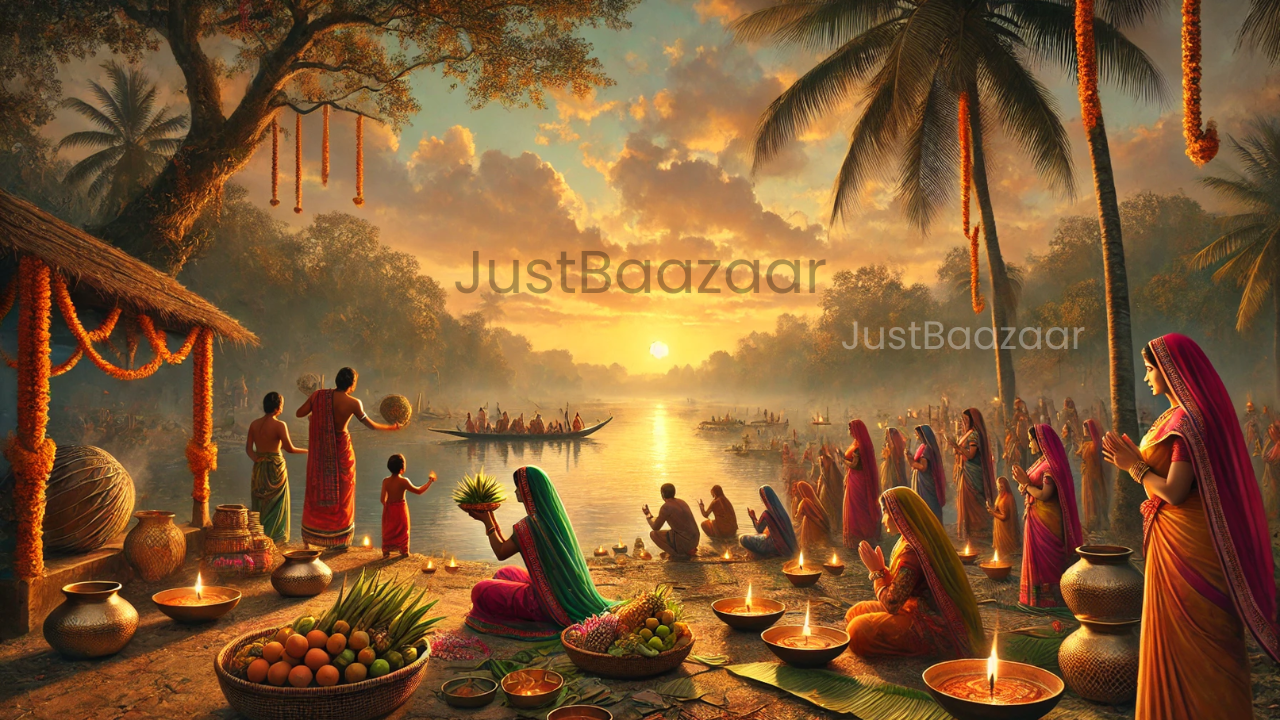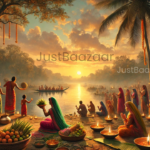Chhath Puja is a vibrant Hindu festival deeply rooted in the ancient Indian tradition of Sun worship. Celebrated predominantly in Bihar, Jharkhand, Uttar Pradesh, and Nepal, it is known for its unique rituals and powerful expressions of gratitude toward Surya Dev (the Sun God) and Chhathi Maiya (Mother Goddess Shashthi). The festival honors the vital energy that sustains life on Earth and connects devotees with nature in a profound way. Chhath Puja history and origin.
🌅 Chhath Puja: Story, History, Origin, Anecdotes, Popular Events, and How to Celebrate 🌞
In this detailed guide, we’ll explore the story, history, origin, famous events, anecdotes, and celebration procedures of Chhath Puja, providing a comprehensive view of this cherished festival.
🌞 Story and Mythological Background of Chhath Puja
Chhath Puja has its roots in ancient Hindu scriptures and mythology, connecting the festival to many divine stories:
- Legend of Draupadi and Pandavas
The story of Chhath Puja is found in the Mahabharata, where Draupadi and the Pandavas perform this festival to regain their lost kingdom. The ritual of Chhath Puja was believed to invoke the Sun God, who blessed them with prosperity and peace. - The Story of Lord Rama and Sita
Another legend links Chhath Puja to Lord Rama and Sita. After their return to Ayodhya from exile, Lord Rama and Sita observed a fast and offered prayers to the Sun God to express their gratitude and to seek blessings for their kingdom’s prosperity. This event marked the origin of the Chhath Puja tradition. - The Story of Karna
In Mahabharata, Karna, the son of Surya Dev, is often depicted worshipping the Sun with utmost devotion. He would stand in water up to his chest and offer Arghya (water offering) to the Sun God every morning. This worship form laid the foundation for many elements seen in Chhath Puja today.
These stories illustrate that Chhath Puja has a mythological significance, as it was performed by many prominent figures to seek blessings, strength, and prosperity.
🕉️ Historical and Cultural Origin of Chhath Puja
Chhath Puja dates back to ancient Vedic times when worshipping natural forces like the Sun was common in India. The Vedas mention several hymns devoted to Surya Dev, highlighting the importance of solar energy in sustaining life.
- Vedic Connection: The Vedic texts often emphasized the importance of the Sun in both spiritual and physical health. Sun worship was considered crucial for purifying the mind and body.
- Sustainable Traditions: Historically, Chhath Puja is known for its sustainable practices, avoiding the use of artificial materials or polluting items. Instead, all rituals involve eco-friendly elements such as clay lamps, natural fruits, and leaves, connecting participants directly to nature.
- Expansion Over Centuries: While Chhath Puja was initially limited to specific regions, migration patterns have led to its celebration in various parts of India and even abroad, making it a globally recognized festival.
This festival’s cultural origins reflect the ancient Indian belief in respecting and nurturing the elements of nature, establishing a harmonious balance between humans and their environment.
🌸 Anecdotes and Folklore Around Chhath Puja
Chhath Puja is rich with folklore, each anecdote adding to the festival’s mystique:
- Devotees’ Miraculous Healing Stories: Many devotees believe that observing Chhath Puja has cured illnesses and brought peace to their lives. People often share stories of miraculous recoveries, attributing them to the blessings of Surya Dev and Chhathi Maiya.
- Family Legacies of Worship: In many families, Chhath Puja has been observed for generations. Grandmothers often share stories about how they first learned the rituals, passing down techniques, songs, and recipes to their children and grandchildren.
- Songs and Hymns of Chhath: The traditional songs sung during Chhath Puja have significant cultural value. Songs like “Kanch Hi Baans Ke Bahangiya” are more than melodies; they are carriers of history and emotions, recalling memories of past celebrations and connecting people to their roots.
🎉 Popular Events and Celebrations During Chhath Puja
Chhath Puja is not only a personal ritual but also a grand community event. Major cities like Patna, Varanasi, and Delhi organize large-scale celebrations at riverbanks and ghats.
- Patna’s Ganga Ghats: Patna, the capital of Bihar, witnesses thousands of devotees gathered along the Ganga Ghats. The entire area is beautifully decorated with lights, and the riverbank becomes a place of devotion, with families and friends offering prayers together.
- Festivities in Varanasi: The ghats of Varanasi come alive during Chhath Puja, with devotees and tourists visiting the ghats to witness the holy Arghya (water offering). The serene setting of Varanasi enhances the spiritual experience for devotees.
- Community Events and Cultural Performances: In many places, Chhath Puja is accompanied by cultural performances, traditional folk music, and dance that enrich the celebratory atmosphere and encourage the younger generation to participate actively.
🛐 How to Celebrate Chhath Puja: Rituals and Procedures
Chhath Puja is a four-day festival, each day with its specific rituals:
🌅 Day 1: Nahay Khay
- Description: The first day of Chhath Puja is known as Nahay Khay. Devotees take a holy dip in the river or any clean water source, symbolizing purification. They then prepare vegetarian meals, usually consisting of rice, dal, pumpkin, and bottle gourd.
- Significance: This meal signifies the beginning of the fasting period. It is considered pure, and only after offering it to the deity do the devotees consume it.
🌅 Day 2: Kharna
- Description: On this day, devotees observe a day-long fast, breaking it only after sunset. A special prasad made of rice kheer (rice pudding), puris, and bananas is prepared.
- Significance: The evening prasad is offered to Chhathi Maiya and then shared with family and friends, symbolizing gratitude and unity. From this night onwards, devotees observe a strict fast without water until the final day of Chhath.
🌅 Day 3: Sandhya Arghya (Evening Offering)
- Description: Devotees gather at riverbanks or ponds to offer prayers to the setting sun, Surya Dev. They carry baskets filled with fruits, thekua (a traditional sweet), and other offerings.
- Rituals: Women dress in traditional sarees, and men and children also wear ethnic attire. Everyone sings folk songs, and the atmosphere is filled with devotion.
- Significance: Offering Arghya to the setting sun is a way to thank Surya Dev for sustaining life. This ritual fosters a sense of gratitude and reverence.
🌅 Day 4: Usha Arghya (Morning Offering)
- Description: On the final day, devotees return to the riverbank before dawn to offer Arghya to the rising sun.
- Rituals: The worshippers stand in the water, holding baskets of offerings above their heads, and pray for family welfare, health, and prosperity.
- Breaking the Fast: After the offering, devotees break their fast by eating ginger with water and then distribute prasad among family and friends.
- Significance: Usha Arghya symbolizes new beginnings and the blessings of a fresh start. The prayers to the rising sun reflect hope, prosperity, and well-being.
🌸 Essential Items and Prasad for Chhath Puja
Each item used in Chhath Puja holds a specific meaning:
- Thekua: A wheat flour and jaggery sweet, symbolizing nourishment and purity.
- Sugarcane, Coconuts, and Bananas: Natural elements that signify prosperity and abundance.
- Earthen Lamps (Diya): These diyas symbolize purity and the elimination of darkness, serving as a guide during evening and morning Arghya.
- Traditional Saree: Women wear a special yellow or red saree, which is considered auspicious for the ritual.
🌞 Tips for a Safe and Eco-Friendly Chhath Puja
Given the environmental impact of large-scale celebrations, here are some ways to keep Chhath Puja eco-friendly:
- Use Biodegradable Offerings: Avoid plastic and use natural items like bamboo baskets, leaves, and organic materials.
- Opt for Natural Colors: If decorating the area or diyas, use natural colors or materials that won’t harm water bodies.
- Limit Fireworks: Avoid polluting the air with excessive fireworks, especially near water bodies.
- Clean Up After Rituals: After completing Arghya, clean the area, taking all items back with you or placing them in appropriate disposal areas.
🌸 Conclusion: The Timeless Relevance of Chhath Puja
Chhath Puja is more than a festival; it is a connection between humanity and nature, a humble acknowledgment of life’s essential elements. Through Chhath, devotees learn to live harmoniously with nature, honoring the Sun and the Earth’s resources.
This festival represents faith, family bonds, and cultural pride, passed down from generation to generation. As devotees pray to Surya Dev and Chhathi Maiya, they embrace the importance of gratitude, patience, and resilience. Whether celebrated on the Ganga ghats in Patna or by a small pond in a village, Chhath Puja continues to unify people and bless them with prosperity and hope for the future.
🌅 छठ पूजा: कहानी, इतिहास, उत्पत्ति, लोक कथाएँ, प्रसिद्ध आयोजन, और मनाने की विधि 🌞

छठ पूजा भारत का एक प्राचीन पर्व है जो सूर्य देव और छठी मइया को समर्पित है। यह त्योहार बिहार, झारखंड, उत्तर प्रदेश और नेपाल में विशेष रूप से मनाया जाता है और इसके अनोखे रीति-रिवाज, प्रकृति के प्रति आभार और भक्ति के लिए जाना जाता है। सूर्य देव को जीवनदायी ऊर्जा का स्रोत मानते हुए लोग उनके प्रति अपनी श्रद्धा व्यक्त करते हैं।
इस विस्तृत मार्गदर्शिका में हम छठ पूजा की कहानी, इतिहास, उत्पत्ति, प्रसिद्ध आयोजन, लोक कथाएँ, और इसे मनाने की विधि पर चर्चा करेंगे, जो इस पर्व को गहराई से समझने में आपकी मदद करेगी।
🌞 छठ पूजा की कहानी और पौराणिक पृष्ठभूमि
छठ पूजा का संबंध हिंदू धर्मग्रंथों और पौराणिक कथाओं से है। इसके कई कथानक हैं, जिनसे इस पर्व की महिमा बढ़ती है:
- द्रौपदी और पांडवों की कथा
महाभारत में द्रौपदी और पांडवों ने अपने खोए हुए राज्य को वापस पाने के लिए छठ पूजा का व्रत किया था। इस पूजा से सूर्य देव प्रसन्न हुए और उन्होंने उन्हें आशीर्वाद दिया, जिससे उनके जीवन में शांति और समृद्धि आई। - भगवान राम और सीता की कथा
एक अन्य कथा के अनुसार, जब भगवान राम और सीता वनवास से अयोध्या लौटे, तब उन्होंने सूर्य देव की उपासना और छठ पूजा का अनुष्ठान किया। यह उनके राज्य की समृद्धि और शांति के लिए की गई प्रार्थना थी। - कर्ण की कथा
महाभारत में सूर्यपुत्र कर्ण रोज़ाना सूर्य को अर्घ्य अर्पण करते थे। वे सूर्य देव के परम भक्त थे और उनकी भक्ति का यह रूप छठ पूजा का आधार बना। आज भी लोग पानी में खड़े होकर सूर्य को अर्घ्य अर्पण करते हैं, जो कर्ण की पूजा पद्धति का अनुसरण है।
इन कहानियों से छठ पूजा की पौराणिक महत्ता का पता चलता है, क्योंकि इसे बड़े-बड़े महापुरुषों ने अपनी इच्छाओं की पूर्ति के लिए किया था।
🕉️ छठ पूजा का ऐतिहासिक और सांस्कृतिक उत्पत्ति
छठ पूजा का इतिहास वैदिक काल से जुड़ा हुआ है जब भारतीय समाज में प्राकृतिक शक्तियों की पूजा महत्वपूर्ण मानी जाती थी। वैदिक ग्रंथों में सूर्य देव को समर्पित कई स्तोत्र मिलते हैं, जो इस पूजा की प्राचीनता को दर्शाते हैं।
- वैदिक संबंध: वैदिक ग्रंथों में सूर्य की महिमा का वर्णन है, जिसमें उन्हें शारीरिक और मानसिक स्वास्थ्य के लिए महत्वपूर्ण माना गया है।
- पर्यावरण-संरक्षण: छठ पूजा के सभी अनुष्ठानों में प्राकृतिक और पर्यावरण-अनुकूल सामग्रियों का उपयोग किया जाता है। इसमें प्लास्टिक का उपयोग नहीं होता, जिससे पर्यावरण की सुरक्षा होती है।
- विस्तार और लोकप्रियता: पहले यह पर्व केवल कुछ राज्यों में मनाया जाता था, लेकिन प्रवासियों के कारण अब इसे अन्य स्थानों और विदेशों में भी मनाया जाता है।
छठ पूजा की सांस्कृतिक उत्पत्ति दर्शाती है कि यह प्रकृति के तत्वों का सम्मान करने और पर्यावरण से संतुलन बनाए रखने का प्रतीक है।
🌸 छठ पूजा से जुड़ी लोक कथाएँ और कहानियाँ
छठ पूजा से जुड़ी कई लोक कथाएँ हैं जो इस पर्व को और भी रहस्यमय और समृद्ध बनाती हैं:
- चमत्कारिक उपचार की कहानियाँ: कई भक्तों का मानना है कि छठ पूजा के व्रत से उन्हें अद्भुत रूप से बीमारियों से छुटकारा मिला है और उनके जीवन में शांति आई है।
- पीढ़ी दर पीढ़ी छठ की परंपरा: कई परिवारों में छठ पूजा पीढ़ियों से मनाई जा रही है। दादी-नानी अपनी परंपराएं और रीति-रिवाज अगली पीढ़ी को सिखाती हैं, जो उनके परिवार का गौरव बनता है।
- छठ के गीत: छठ पूजा के दौरान गाए जाने वाले गीत जैसे “कांच ही बांस के बहंगिया” केवल संगीत नहीं हैं, बल्कि ये हमारी सांस्कृतिक धरोहर हैं जो हमारे पूर्वजों की भावनाओं और स्मृतियों को जीवित रखते हैं।
🎉 छठ पूजा के प्रसिद्ध आयोजन और उत्सव
छठ पूजा केवल व्यक्तिगत अनुष्ठान ही नहीं, बल्कि एक भव्य सामुदायिक आयोजन भी है। भारत के प्रमुख शहरों में बड़े पैमाने पर इसे मनाया जाता है:
- पटना के गंगा घाट: पटना में गंगा के किनारे हज़ारों भक्त एकत्रित होते हैं। पूरा इलाका दीपों और सजावट से भरा होता है, जहां परिवार और मित्र मिलकर पूजा करते हैं।
- वाराणसी में उत्सव: वाराणसी के घाट छठ पूजा के समय जीवंत हो जाते हैं। लोग बड़ी संख्या में गंगा के किनारे सूर्य को अर्घ्य देने आते हैं, जिससे वहां की पवित्रता और बढ़ जाती है।
- सामुदायिक आयोजन और सांस्कृतिक कार्यक्रम: कई स्थानों पर छठ पूजा के साथ सांस्कृतिक प्रस्तुतियां होती हैं, जैसे लोक नृत्य और संगीत, जो इसे एक महोत्सव का रूप देते हैं।
🛐 छठ पूजा कैसे मनाएं: अनुष्ठान और प्रक्रिया
छठ पूजा चार दिनों तक चलने वाला पर्व है और हर दिन के अलग-अलग अनुष्ठान होते हैं:
🌅 दिन 1: नहाय खाय
- विवरण: छठ पूजा का पहला दिन नहाय खाय कहलाता है। भक्त किसी पवित्र जल स्रोत में स्नान करते हैं और शुद्ध भोजन ग्रहण करते हैं। इसमें कद्दू-भात, चने की दाल और चावल का भोजन होता है।
- महत्व: यह भोजन व्रत का प्रारंभ होता है और इसे छठी मइया को समर्पित किया जाता है।
🌅 दिन 2: खरना
- विवरण: इस दिन भक्त दिनभर का उपवास रखते हैं और सूर्यास्त के बाद इसे तोड़ते हैं। इस दिन प्रसाद में चावल की खीर, रोटी और केले का प्रयोग होता है।
- महत्व: खरना का प्रसाद भक्त अपने परिवार और मित्रों के साथ साझा करते हैं, जिससे यह आभार और एकता का प्रतीक बनता है। इस दिन से ही निर्जला व्रत का पालन शुरू होता है।
🌅 दिन 3: संध्या अर्घ्य (संध्या को सूर्य को अर्घ्य देना)
- विवरण: तीसरे दिन भक्त नदी या तालाब के किनारे सूर्य देव को अर्घ्य अर्पित करते हैं। वे अपने साथ फलों, ठेकुआ (मीठी रोटी), और अन्य प्रसाद की टोकरी लाते हैं।
- रिवाज़: महिलाएं पारंपरिक साड़ी पहनती हैं और बच्चे और पुरुष भी पारंपरिक पोशाक में होते हैं। भक्त भक्ति गीत गाते हैं और माहौल भक्ति से भरा होता है।
- महत्व: संध्या अर्घ्य में ढलते सूर्य को अर्घ्य देना आभार प्रकट करने का एक तरीका है।
🌅 दिन 4: उषा अर्घ्य (प्रातः कालीन अर्घ्य)
- विवरण: अंतिम दिन भक्त सुबह जल्दी नदी किनारे जाकर उगते सूर्य को अर्घ्य देते हैं।
- रिवाज़: भक्त पानी में खड़े होकर प्रसाद की टोकरी हाथ में लेकर सूर्य देव से प्रार्थना करते हैं और परिवार के लिए सुख-शांति की कामना करते हैं।
- व्रत तोड़ना: अर्घ्य के बाद भक्त अपना व्रत तोड़ते हैं, अदरक के साथ जल ग्रहण करते हैं और प्रसाद बांटते हैं।
- महत्व: उषा अर्घ्य नए आरंभ और समृद्धि का प्रतीक है। उगते सूर्य की प्रार्थना आशा और खुशहाली का प्रतीक होती है।
🌸 छठ पूजा के लिए आवश्यक सामग्री और प्रसाद
छठ पूजा की हर सामग्री का विशेष महत्व है:
- ठेकुआ: गेहूं और गुड़ से बना हुआ यह मीठा प्रसाद पोषण और पवित्रता का प्रतीक है।
- गन्ना, नारियल, और केला: ये प्राकृतिक उपहार समृद्धि और प्रचुरता का संकेत देते हैं।
- मिट्टी के दीपक: ये दीपक शुद्धता का प्रतीक हैं और अंधकार को दूर कर पूजा स्थल को प्रकाशित करते हैं।
- पारंपरिक साड़ी: महिलाएं विशेष पीली या लाल साड़ी पहनती हैं, जिसे पूजा के लिए शुभ माना जाता है।
🌞 पर्यावरण के अनुकूल छठ पूजा के लिए सुझाव
बड़े पैमाने पर मनाए जाने वाले त्योहारों का पर्यावरण पर भी प्रभाव पड़ता है। इसे पर्यावरण के अनुकूल बनाने के कुछ सुझाव:
- बायोडिग्रेडेबल सामग्री का उपयोग करें: प्लास्टिक का उपयोग न करें, बांस की टोकरियाँ, पत्तियाँ और जैविक सामग्री का उपयोग करें।
- प्राकृतिक रंगों का प्रयोग करें: यदि सजावट करनी हो, तो प्राकृतिक रंगों का प्रयोग करें।
- फटाखों का सीमित उपयोग: खासकर जल निकायों के पास प्रदूषण फैलाने से बचें।
- पूजा स्थल की सफाई करें: अर्घ्य के बाद पूजा स्थल की सफाई करना न भूलें।
🌸 निष्कर्ष: छठ पूजा की अनंत महिमा
छठ पूजा केवल एक त्योहार नहीं, बल्कि मानव और प्रकृति के बीच संतुलन बनाने का एक अवसर है। यह हमें यह सिखाता है कि हमें जीवन में दी जाने वाली सभी प्राकृतिक संपदाओं के लिए आभार व्यक्त करना चाहिए।
छठ पूजा हमें भक्ति, परिवार के बंधन और सांस्कृतिक गर्व का प्रतीक है जो पीढ़ी दर पीढ़ी सिखाया जाता है। चाहे पटना के गंगा घाट हों या किसी गांव का तालाब, छठ पूजा सभी को एकता के सूत्र में बांधती है और भविष्य के लिए समृद्धि और आशा का आशीर्वाद देती है। 🌞
Related Posts on Chhath Puja:
- Chhath Puja Wishes in Sanskrit
- Chhath Puja Rituals
- Story of Chhath Puja
- Whatsapp Status on Chhath Puja
- Social Media Content Post Ideas on Chhath Puja
- Chhath Puja Wishes in Hindi with Emojis
- Chhath Puja Wishes in English with Emojis










